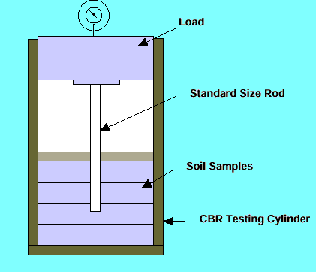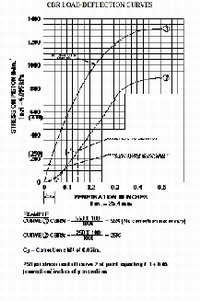C. b. R.
General
|
OverviewDefinition
of CBR The
CBR is a penetration test performed to determine the potential strength
of subgrade, subbase, and base coarse material for use in road and
airfield pavements. The results of this test are used as an integral
part in the design of flexible pavements. CBR
is primarily intended for, but not limited to, evaluating the strength
of cohesive materials having maximum particle sizes less than 19 mm. The
CBR value is determined by noting the stress (in psi) imposed on the
soil being tested, which corresponds to 0.1 in. of penetration by a
standard diameter rod. The CBR value is expressed as a percentage and is
a comparison of penetration resistance of the soil being tested to the
penetration resistance of a standard crushed rock at a penetration of
0.1 in. |
Apparatus |
The apparatus:
|
Procedure
|
Laboratory CBR tests are performed according to the guidelines contained in ASTM D1883. A selected sample of subgrade material is compacted in a cylindrical mold at the optimum moisture and maximum density as determined by Standard or Modified Proctor density tests. After the sample has been compacted a surcharge weight is placed on the sample and the entire assembly immersed in water for four days. At the completion of the soaking period the sample is removed and drained for 15 minutes. The sample is then subjected to penetration by a piston 1.95 in. in diameter (3 in.2 area) and the total loads corresponding to penetration of 0.1, 0.2, 0.3, 0.4 and 0.5 in. are recorded. A
load penetration curve is then drawn, and corrections made to straighten
the concave upward shape of the initial portion of the curve caused by
surface irregularities. The corrected value of unit load for 0.1 in.
penetration is then determined. A typical CBR curve and an example
method of correction are illustrated in Result.
This corrected value is then compared with a value of 1000
psi which is required to effect the same penetration in standard crushed
rock and multiplied by 100 to get percent. Therefore:
|
References
|
|






